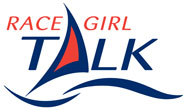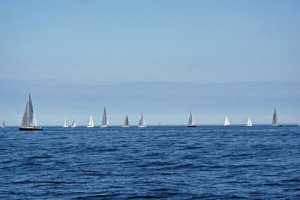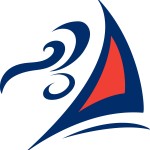Sailboat Racing Trim — Part 6
In Chapter 6 of his book Racing Trim, Bill Gladstone talks about mainsail trim and controls. The following post shows a short summary of that chapter.
A well trimmed mainsail gives the boat speed, allows it to point, and balances the jib to get the boat upwind. During a race, boats will use many different foresails, but typically only one main. So, that main must be much more versatile to accomplish everything that is needed during a race. That highlights, even more, the importance of all the different controls that can be adjusted to trim the main.
The mainsail trimmer needs to watch the wind and water conditions in order to quickly make trim adjustments. This will help the driver steer most effectively and result in the best performance on the race course. The main gets power from the angle of attack. Trimming in gives more power. Raising the traveller and falling off will also increase angle of attack for more power. Deeper sails and a closed leech also create more power.
The main sheet is the primary sail control. Trim so that the leech end of the top batten is parallel with the boom. From here, fine tune the main sheet or trim so that the upper leech telltales are flowing with an “occasional stall.” I’ve heard it said that you sail the front edge of the jib and the back edge of the main. This helps me think about how to trim the main while watching the telltales. Boom vang can help control twist (snug it to do this). However, having the vang too tight in light air will close the leech and stall flow (read as big trouble). Mast bend is the second most powerful main shape control. Putting more bend in the mast will bring the top back, but flex the middle of the mast forward. So, the sail will be flattened (less power). Outhaul is used to control depth on the lower part of the sail. Traveller positions the boom to adjust angle of attack. Traveller needs to be played regularly in puffs. Luff tension adjusts draft position (more tension moves draft forward).
Some boats will respond better to changes in twist. Others will be more responsive to changes in angle of attack. This will depend on the sail design, boat design, and sea state. Test out the different methods of controlling main shape and use what works best for your boat and sails.
In summary:
- Mainsail trim adjustments:
- Main sheet
- Mast bend
- Vang
- Outhaul
- Luff tension
- Traveller
- Power is controlled by:
- Angle of attack
- Depth
- Twist
- For more power:
- Increase depth
- Increase angle of attack
- Decrease twist
If main trimmer has the main trimmed right, balanced with the right jib trim, the driver will have to do much less to steer the boat.
This is the sixth in a series of posts based on Bill Gladstone’s book Racing TRIM from the North U. Series. Periodically, I post about a chapter or two. This will be my short summary of what I’ve read. You can read the posts to get my abbreviated summary; or you could read through the books with me. Your comments can help point out what you find most interesting, or even poke fun at what I do and don’t know. If you are interested in getting this book, you can find it in the online store section of NorthU.com for $25.



